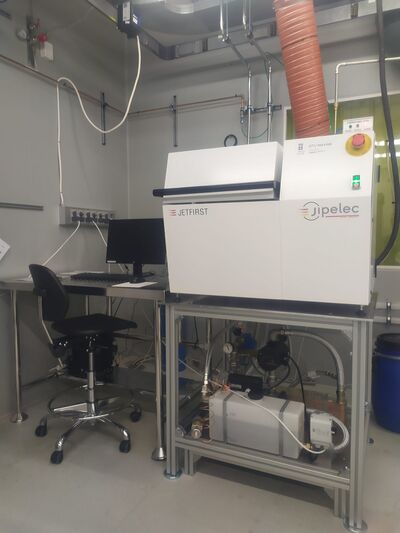Specific Process Knowledge/Thermal Process/RTP Jipelec 2: Difference between revisions
| Line 16: | Line 16: | ||
==The Set-Up== | ==The Set-Up== | ||
[[Image:Tool+operator station.jpg|400px|thumb|RTP2 Jipelec: Position in cleanroom A5]] | |||
The machine consists of a reactor chamber, in which different samples can be processed/annealed at temperatures up to 1200 °C. | The machine consists of a reactor chamber, in which different samples can be processed/annealed at temperatures up to 1200 °C. | ||
The chamber can be heated up very rapidly by the use of 18 infrared halogen lamps that are situated in the chamber lid. A quartz plate is placed below the lamps, i.e. between the lamps and the sample(s). Below the platen, there is an optical pyrometer aligned with the center of the substrate, that is placed on the bottom part of the chamber. The platen presents additional inlets where multiple thermocouples can be mounted. These details are exemplified in images below. | The chamber can be heated up very rapidly by the use of 18 infrared halogen lamps that are situated in the chamber lid. A quartz plate is placed below the lamps, i.e. between the lamps and the sample(s). Below the platen, there is an optical pyrometer aligned with the center of the substrate, that is placed on the bottom part of the chamber. The platen presents additional inlets where multiple thermocouples can be mounted. These details are exemplified in images below. | ||
'''The user manual, user APV, technical information and contact information can be found in LabManager:''' | '''The user manual, user APV, technical information and contact information can be found in LabManager:''' | ||
Revision as of 13:39, 6 November 2023
Feedback to this page: click here
This page is written by DTU Nanolab internal
THIS PAGE IS UNDER CONSTRUCTION
RTP2 Jipelec - Rapid Thermal Processor
The main purpose of the RTP2 Jipelec (Jipelec JetFirst 200 RTP) is to perform thermal processes, using faster heating rates and shorter process durations when compared to conventional methods. This is called rapid thermal processing (RTP) and can be used to treat different types of samples.
Rapid thermal processing typically includes RTA, i.e. Rapid Thermal Annealing, where samples are heated up very rapidly in a nitrogen or argon atmosphere. Contact alloying and RTN, i.e. Rapid Thermal Nitridation, might also be possible for some samples.
The Set-Up

The machine consists of a reactor chamber, in which different samples can be processed/annealed at temperatures up to 1200 °C.
The chamber can be heated up very rapidly by the use of 18 infrared halogen lamps that are situated in the chamber lid. A quartz plate is placed below the lamps, i.e. between the lamps and the sample(s). Below the platen, there is an optical pyrometer aligned with the center of the substrate, that is placed on the bottom part of the chamber. The platen presents additional inlets where multiple thermocouples can be mounted. These details are exemplified in images below.
The user manual, user APV, technical information and contact information can be found in LabManager:
| Purpose | Rapid thermal processor/annealer | |
|---|---|---|
| Process parameter range | Process temperature |
Annealing temperature:
Temperature ramp:
|
| Process pressure |
| |
| Gases on the system |
Process gases:
Purge gas:
| |
| Substrates | Batch size |
|
| Substrate materials allowed |
|
